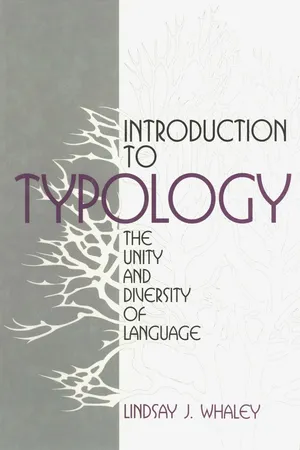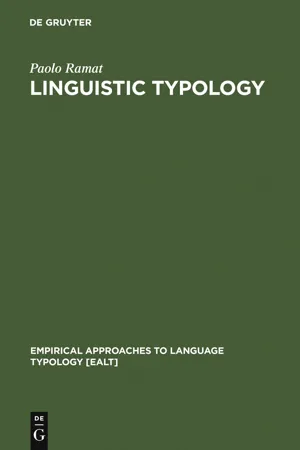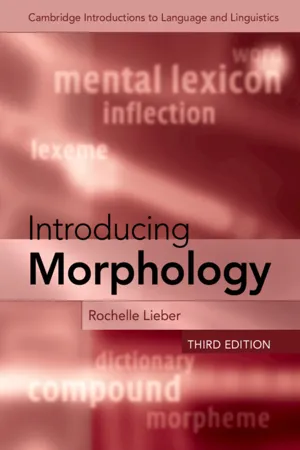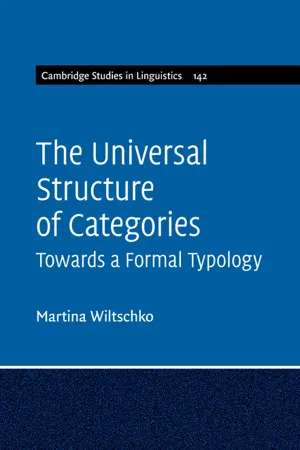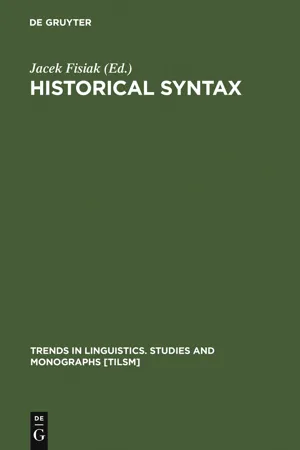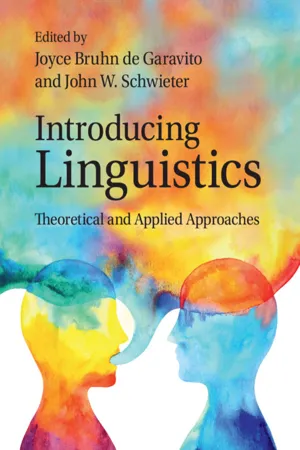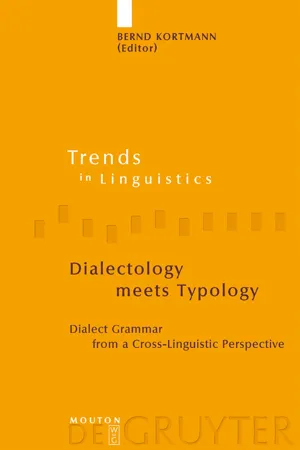Languages & Linguistics
Typology
Typology in linguistics refers to the classification and comparison of languages based on their structural features. It involves identifying and categorizing linguistic patterns and structures across different languages to understand their similarities and differences. Typological studies help linguists gain insights into the universal principles underlying language and the diversity of linguistic systems.
Written by Perlego with AI-assistance
Related key terms
1 of 5
12 Key excerpts on "Typology"
- eBook - ePub
Introduction to Typology
The Unity and Diversity of Language
- Lindsay J. Whaley(Author)
- 1996(Publication Date)
- SAGE Publications, Inc(Publisher)
Which explanation for the similarities between languages is right? In all likelihood, the unity of language, and consequent language universals, arises from a slate of interacting factors, some innate, others functional, and still others cognitive, experiential, social, or historical. What this means in practical terms is that there are a number of legitimate ways to approach the question, “What is language?” This book examines the nature of language from a “typological” approach. In the following section, a better sense for what this means is developed.1.0. Defining “Typology”
What exactly is meant by Typology in the context of linguistics? In its most general sense, Typology is(2) The classification of languages or components of languages based on shared formal characteristics. As a point of departure, it is important to note that Typology is not a theory of grammar.3 Unlike Government and Binding Theory, Functional Grammar, Cognitive Grammar, Relational Grammar, or the many other frameworks that are designed to model how language works, Typology has the goal of identifying cross-linguistic patterns and correlations between these patterns. For this reason, the methodology and results of typological research are in principle compatible with any grammatical theory. The relationship between Typology and theories of grammar is further explored later in this chapter and in Chapter 3 .Having described something that Typology is not, we now must come to understand what it is. There are three significant propositions packed into the dense definition in (2): (a) Typology utilizes cross-linguistic comparison, (b) Typology classifies languages or aspects of languages, and (c) Typology examines formal features of languages. These parts of the definition will be examined one at a time with an eye to better understanding what is involved in performing language Typology.Proposition 1: Typology involves cross-linguistic comparison.Ultimately, all typological research is based on comparisons between languages. Consider the following data:(3) a. I met the man who taught you French. b. The dog which licked Cora has become her friend. c. I sent the story to the newspaper - eBook - PDF
- Paolo Ramat, A. P. Baldry(Authors)
- 2011(Publication Date)
- De Gruyter Mouton(Publisher)
The possibility of various approaches to Typology emerges very clearly from the three definitions listed by Shurinskaja (1975: 438) 1. Typology as a science that studies individual types of language, language types and which, finally, determines the most essential and specific characteristics of natural languages; 2. Typology of language as a structure, considered in reference to types that appear in language (Typology of a given language or specific groups of languages, Typology of individual levels and categories, e. g., 'semantic Typology', 'Typology of the verb genus', etc., 3. Typology as an organizational principle of linguistic material, which makes it possible to give a typological description of the language in question and its similarities and differences as compared with other languages ... .This description should obviously be the crowning achieve-ment of linguistic analysis, should conclude and summarize it (cf. Pottier 1968: 300). Common to all three definitions is the comparative dimension, but this still does not resolve the inductive/deductive issue: whether the stress is placed on a characterisation of languages according to their intrinsic properties considered sufficiently characterizing, or whether we proceed with a classification of languages on the basis of the presence or absence of certain predetermined characteristics (see Jucquois 1975: 18, Altmann-Lehfeldt 1973: 13 f.), we need to have a reference point (inside the particular language in the first case, outside the particular language in the second case). We need, in other words, a fixed parameter with which to compare the multiplicity of language data. We cannot dispense with this parameter. Jucquois (1975: 45) writes Dans la mesure ou la typologie se propose d'etre ... un instrument pour olaborer une linguis-tique generale, eile devra deboucher sur une theorie linguistique en principe absente au depart and adds in brackets: c'est le cas de la typologie descriptive. - Sylvain Auroux, E.F.K. Koerner, Hans-Josef Niederehe, Kees Versteegh, Sylvain Auroux, E.F.K. Koerner, Hans-Josef Niederehe, Kees Versteegh, Sylvain Auroux, E. F. K. Koerner, Hans-Josef Niederehe, Kees Versteegh(Authors)
- 2008(Publication Date)
- De Gruyter Mouton(Publisher)
XXVII. Language Typology, Language Classification, and the Search for Universals Sprachtypologie, die Klassifizierung der Sprachen und die Suche nach sprachlichen Universalien La typologie linguistique, la classification des langues et la recherche des universaux 171. Typology by the end of the 18th century 1. The programme 2. Two themes for variation: The 17th century 3. Variations on a few themes: The 18th century 4. Eclipse of the Enlightenment 5. Bibliography 1. The programme Typology is a research programme aimed at mapping cross-linguistic diversity and distin-guishing what is systematic about it from what is random. Typological research com-mences by identifying differences among lan-guages, as opposed to traits shared univer-sally. Typology’s remit then is to determine whether these individual differences are inter-related or independent of each other, steering clear of such interrelationships as are due to logical necessity, historical contingency (com-mon heritage or joint borrowing), or chance. Typology, thus, is not so much about the classification of languages as about the distri-butions of individual traits units, cate-gories, constructions, rules of all kinds across the linguistic universe; these distribu-tions, not languages as such, are the primary objects of comparison.- Haspelmath Martin(Author)
- 2008(Publication Date)
- De Gruyter Mouton(Publisher)
Preliminary remarks 2. Typological parameters 3. Theoretical concepts 4. Areal Typology 5. References 1. Preliminary remarks Linguistic Typology can be defined as the sys-tematic study of crosslinguistic variation. This definition presupposes that there are certain general principles governing variation among languages, and I shall simply make this presupposition. One feature of this defi-nition that might at first sight seem strange is that it makes no mention of the notion ‘lin-guistic type’. Indeed, some approaches to lin-guistic Typology do make crucial use of the notion ‘linguistic type’, albeit interpreting this notion in different ways, while other ap-proaches make little or no use of the notion, a point to which I shall return below. Linguistic Typology does, however, assume that we have some yardstick against which to assess crosslinguistic variation. Nearly all current work in linguistic Typology makes a further assumption, namely that this yard-stick or these yardsticks relate to significant factors of linguistic structure. This is not logi-cally necessary, as can be seen by comparing one of the few recent works in linguistic ty-pology that does not make this assumption, namely Vennemann (1984). Theo Vennemann is concerned most di-rectly with word order Typology and in the 1984 article, in contrast to much of his own earlier work, he argues that the notion of ideal linguistic type, such as being consistent in the position of the head of a phrase (con-sistently head-final or consistently head-ini-tial), is not to be interpreted as a natural cor-relation of logically independent parameters (the position of the noun in the noun phrase, the position of the adposition in the adposi-tion phrase, etc.), but rather as an essentially arbitrary yardstick against which languages can be measured.- eBook - PDF
- Rochelle Lieber(Author)
- 2021(Publication Date)
- Cambridge University Press(Publisher)
We can compare languages to each other to see if characteristics of their morphological systems correlate in any way with other parts of their grammars, say their syntax or their phonology. And we can look at the distribution of morphological patterns in terms of genetic relationships (language families) or areal tendencies (where languages are spoken in the world). Studying language from this sort of global perspective is the subject of linguistic Typology. 7.2 Universals and Particulars: A Bit of Linguistic History The history of linguistics has for centuries seen a tug of war between theories that emphasize universals – those things that are common to all human languages, perhaps because they are part of our common bio- logical endowment – and particulars – those things that look unique and appear to distinguish languages from one another. At the turn of the twentieth century, partly as a legacy of colonialism, linguists started studying indigenous languages of Africa, Asia, and the Americas more seriously. In North America, the tradition of American Structuralism stressed the uniqueness of languages, not surprising, con- sidering the linguistic diversity of indigenous North American languages and their prodigious differences from one another and from better stud- ied Indo-European languages. With the advent of Generative Grammar in the middle of the twentieth century, the pendulum began to swing in the other direction. Chomskians stressed what’s universal in languages, and searched for ways to explain linguistic differences as the result of small choices that languages make from a universal set of options that our biological make-up, our hard-wiring for language as it were, makes available. All linguists today, whatever their theoretical commitments, recognize the importance of looking at a broad range of languages to observe both commonalities and differences. - eBook - PDF
- Martina Wiltschko(Author)
- 2014(Publication Date)
- Cambridge University Press(Publisher)
Instead, what I tried to show here is that substantive content is necessarily supplied by language- specific UoLs. 299 In this chapter, I present the basis for a formal Typology of categorization, based on the Universal Spine Hypothesis (USH). I start in Section 8.2 with a brief overview of the difference between linguistic Typology and formal grammar. Linguistic Typology is typically associated with functional explan- ations. This is however not a necessary correlation. There is no intrinsic reason as to why a Typology could not be formal. And indeed, I argue in Section 8.3 that a formal Typology is not only possible but is also necessary. I then show in Section 8.4 that there are indeed some existing formal criteria for classification, typically assumed to be universally applicable. However, I also show that these criteria are insufficient at best and misleading at worst. In section 8.5, I distill the formal classification criteria based on the USH. In section 8.6 I draw conclusions and raise open questions. And finally, in section 8.7, I identify the USH as a research agenda. 8.2 Linguistic Typology and formal grammar The languages of the world differ, yet they do so in systematic ways. Linguistic Typology is inherently concerned with cross-linguistic comparison. It refers to a “classification of structural types across languages” (Croft 2003: 1). There are two principal goals: i) to explore linguistic diversity by classifying categories and structures ii) to explore language universals by seeking patterns that occur sys- tematically across related and unrelated languages Linguistic Typology is often presented as being in opposition to formal gram- mar (see Polinsky [2010] for a recent overview). This opposition manifests itself in the primary goals associated with each approach. - eBook - PDF
- Jacek Fisiak(Author)
- 2010(Publication Date)
- De Gruyter Mouton(Publisher)
3 If this is so, then a linguistic Typology of this Typology, universals and change of language 597 sort presupposes a theory of linguistic preference (naturalness, markedness, etc.) as well as, by implication, a general grammatical theory. In either case, linguistic typologies are not parts of the respective linguistic theories. Both a general grammatical theory and a theory of linguistic pref-erence (naturalness, markedness, etc.) are formulated withoud any reference to typological concepts — or, at least, they can be, and in my opinion they should be, as they have nothing to gain from such an association. The con-verse is not true. Therefore, linguistic typologies, if conceived in agreement with the introductory remarks of this section, are applications of certain linguistic theories. As applications, they must be developed for some specific purpose. What precisely is this purpose? 4. As a succinct characterization of the goals of linguistic Typology, let us consider the following quotation taken from a monograph on Typology (Alt-mann-Lehfeldt!973:15): Unter den Zielen einer allgemeinen Sprachtypologie werden wir im folgenden nur zwei Probleme verstehen: a) die Sprachklassifikation, d.h. den Aufbau eines Ordnungssystems für die natürlichen Sprachen aufgrund ihrer globalen Ähnlichkeit; b) die Aufdeckung des Konstruktionsmechanismus der Sprachen, d.h. den Aufbau eines Beziehungssystems, eines Netzes, an dem man nicht allein die offensichtlichen, kategorischen, sondern auch die laten-ten Mechanismen der Sprache ablesen kann. In order to understand these goals, one has to look at some other concepts and assumptions the authors use. They distinguish partial typologies (Teilty-pologien, 1973:14) from the general Typology of languages (die allgemeine Sprachtypologie). Partial typologies are based on one or a few properties of languages; they result in what they call monothetic classifications (1973:14f., 27). - eBook - PDF
Languages of the World
A Critical Introduction
- Prafull Dhondopant Kulkarni(Author)
- 2019(Publication Date)
- Society Publishing(Publisher)
Typologies of Languages 7 CONTENTS 7.1. Qualitative Typology of Language ................................................... 172 7.2. Morphosyntactic Alignment of Language ........................................ 175 7.3. Phonological Systems ..................................................................... 182 Chapter 7 Summary ............................................................................... 185 Languages of the World: A Critical Introduction 172 You may wonder why the Typology of language has been allotted a chapter of its own when it is precisely the process of categorization that this book is enacting from its inception. Regardless of the validity of such a question, this chapter is designed to summarize the approaches used in categorizing languages. Even where those approaches have already been mentioned in the book, this chapter seeks to organize them into a narrative that can easily be accessed by students. We have selected three main approaches, including the qualitative Typology, morphosyntactic alignment, and phonological systems. 7.1. QUALITATIVE Typology OF LANGUAGE Language is widely acknowledged as having some qualitative aspects (Conboy, 2006). We know that in linguistic Typology, there is a tendency to focus on structural features (Simons and Fennig, 2017). These can be quantified, but in recent times, the role of qualitative research has gained prominence on the table of academia (Tucker and Bryan, 2017). Even as we describe the structures of a language, we are also trying to highlight their subjective meaning and relevance to the community that uses those languages (Tucker and Bryan, 2017). In this way, we are able to acknowledge the diversity of language and even use this diversity as a stepping stone for developing further linguistic knowledge (Ushioda and Dörnyei, 2017). Figure 7.1 highlights these predominant features of a qualitative Typology of language classification. - Martin Haspelmath, Ekkehard König, Wulf Oesterreicher, Wolfgang Raible, Martin Haspelmath, Ekkehard König, Wulf Oesterreicher, Wolfgang Raible(Authors)
- 2008(Publication Date)
- De Gruyter Mouton(Publisher)
Yet, lexical-typological studies re-mained disiecta membra. So, in 1992 Lehrer still deplored (249 f.) that lexical Typology was not mentioned in the two recent linguistic encyclopedias Crys-tal 1987 and Newmeyer 1988. The same holds for Glück 1993. Similarly, a few years ago, 85. Lexical Typology from a cognitive and linguistic point of view 1143 König (1996: 48) and Lang (1996: 314) found lexical Typology still in its infancy. We should not neglect, however, the less spectacular contributions of (even traditional) contrastive and structural linguistics and of anthropology to lexical Typology (see also below 3.2.1., 3.3.3., 4.4.2., 5.1., 5.2., and 6.). After all, a first — at that time up-to-date — synthesis of what could be called 'lexical ty-pology' was written, not surprisingly, from the point of view of contrastive linguistics (Schepping 1985). In order to systematize relevant problems and achievements, we first have to define the central task of lexical Typology and then re-late it to essential aspects of human language and of language studies. As Lehrer puts it, lexical Typology is concerned with the char-acteristic ways in which language [...] pack-ages semantic material into words (1992: 249). More precisely, problems of lexical ty-pology are only a subset of the problems linked to the universal of 'discursivity', as defined by Oesterreicher: In meinen Augen ist die Diskursivität insofern als der für jede ernstzunehmende typologische Forschung unverzichtbare Grundbegriff zu betrachten, als mit ihm notwendig die Betrachtung der Prinzipien der Verknüpfung von Inhaltspro-zessen mit Ausdrucksprozessen gefordert ist, als mit ihm die Zeichenbildung auf allen re-levanten Ebenen der sprachlichen Strukturie-rung ins Zentrum rückt (1989: 241 f.).- eBook - PDF
Introducing Linguistics
Theoretical and Applied Approaches
- Joyce Bruhn de Garavito, John W. Schwieter(Authors)
- 2021(Publication Date)
- Cambridge University Press(Publisher)
267 7.3 The Typological Classification of Languages • The Sino-Austric hypothesis, which relates Chinese and Tibetan languages with Austroasiatic languages (including Vietnamese and Khmer), Austronesian languages (such as Filipino, Malagasy, and Hawaiian), as well as Thai and Hmong-Mien languages; and • The Borean hypothesis, which includes all of the above language families. 7.3 The Typological Classification of Languages Besides their genetic relatedness to other languages, languages can also be classified by their linguistic features. Since languages differ on many aspects at various levels – phonology, morphology, syntax, semantics – numerous typological classifications have been devised. Below, we will consider three such classifications that fall into the domains of morphology, syntax, and semantics. 7.3.1 Morphological Types The first typological classification to be considered here involves the ways in which languages build words out of morphemes. There are three major types of languages with respect to the way their morphology operates: isolating, agglutinative, and fusional. In an isolating language (not to be confused with an isolate language), words typically consist of one or two morphemes, and grammatical meanings such as num- ber or tense are expressed not by affixes attached to nouns or verbs, but by separate words. An example of a language with (mostly) isolating morphology is Mandarin Chinese. In Mandarin, plurality is not expressed by an affix on the noun, but by a separate word. As you can see in example (4), Mandarin has marked plural with the (unbound) word ji 3 (note that the superscripted numbers indicate tones on the pre- ceding vowels). (4) In an additional twist, the presence of the plural word requires yet another word, called a classifier, which makes the noun itself countable. Classifiers are some- what like words such as grain in a grain of sand in English, which are sometimes called massifiers. - eBook - PDF
Dialectology meets Typology
Dialect Grammar from a Cross-Linguistic Perspective
- Bernd Kortmann(Author)
- 2008(Publication Date)
- De Gruyter Mouton(Publisher)
From a somewhat more elaborate perspective, dialectologists are interested in linguistic variation on the level of dialects and its geographical and social diffusion, its historical, political and cultural motivation and its quantification as discussed in dialectometry and multivariant scaling. Most dialectological studies cover dialects of one and the same language. Some famous examples are Georg Wenker’s (1895) Sprachatlas des Deutschen Reiches , Jules Gilliéron’s (1902–1910) Atlas linguistique de la France , Karl Jaberg and Jakob Jud’s (1928–1940) Sprach- und Sachatlas Italiens und der Südschweiz and The Survey of English Dialects conceived by Eugen Dieth and Harald Orton (1962–1978). In addition, there are also studies dealing with the diffusion of structural properties across languages such as the use of uvular /r/ from Paris up to Copenhagen, Kristiansand and Bergen (Trudgill 1974). If dialectologists deal with linguistic variation from the perspective of dialects, typologists may be said to deal with variation across languages. Typologists try to find out to what extent languages show structural variation and where they follow universal patterns. For that purpose, they set up linguistic types on the basis of empirical cross-linguistic comparison, they try to see whether there are generalizations in the sense of universal patterns of covariation, and they try to explain or motivate these generalizations (Croft 2003: 1–2). Dialectology and Typology – An integrative perspective 13 Even if we disregard the fact that dialectological studies are not always limited to dialects of one language and that typological studies may include some data from dialects of individual languages, the main problem resulting from equating dialectology with variability among dialects and Typology with variability among languages is the fuzzy borderline between what makes a dialect and what makes a language. - Henrik Birnbaum(Author)
- 2018(Publication Date)
- De Gruyter Mouton(Publisher)
Such more deep-seated properties can thus belong to some typological deep structure underlying the surface (as well as DEEP STRUCTURE AND TYPOLOGICAL LINGUISTICS 29 the 'shallow') structure of a particular language as a result of the membership of that language in a typologically defined language group (genetic language family, linguistic convergence area, i.e., Sprachbund, or otherwise); or they can be language-universal properties characteristic of all human language. It follows that the immediately underlying, shallow 'infrastructure' will be the richest and most varied, and, consequently, the least generalized of the deep structure layers ascertainable below the surface of any one language. Conversely, 'profound structure' (as defined above) will be the system most depleted of structural characteristics and relatively poorest as regards multiformity and diversity of seman-tically based categories and relations, and, as a consequence, the one with the maximal degree of generality (equaling universality) and invariance in terms of what can be regarded as specifically LINGUISTIC structure (as opposed to other conceivable systems of communication organized by some structural principle). How-ever, this universality and invariance should not be confused with (structural) amorphousness, as is sometimes suggested or implied. As regards the deep dimension of language, it is thus only at the 'profound' level of semantics-related structure that we can gain any insight into the nature of language per se, while our better understanding of deep structure at the typological and 'shallow' levels could only help us to more adequately assess and charac-terize a particular language type (for details, see below) or an individual language.
Index pages curate the most relevant extracts from our library of academic textbooks. They’ve been created using an in-house natural language model (NLM), each adding context and meaning to key research topics.
